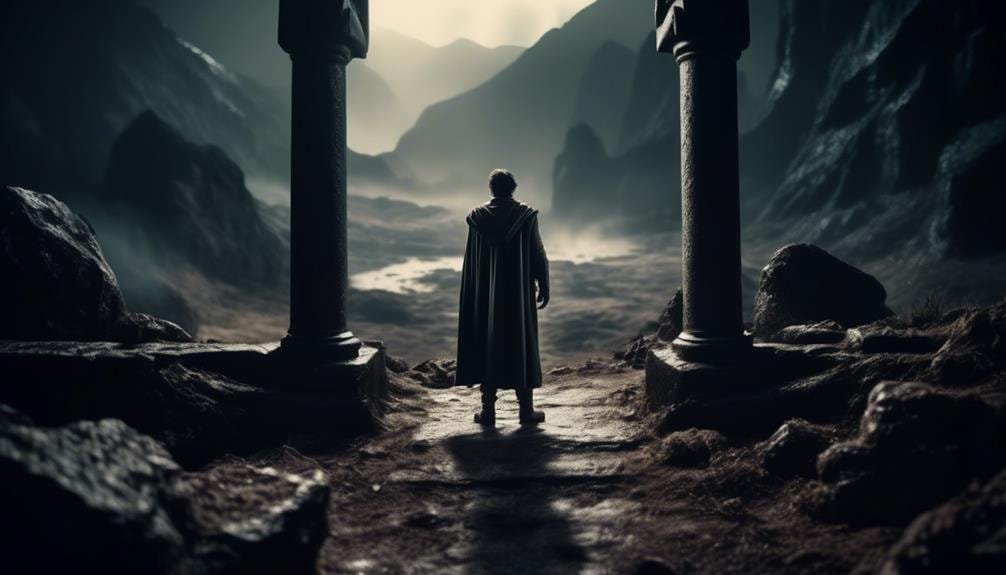Understanding the Hero’s Journey in Storytelling
Have you ever considered the universal truth behind the hero's journey in storytelling? It's a theory that has captivated writers, filmmakers, and audiences for generations.
But is there really a formula that underpins every compelling tale of heroism? As you explore the key stages of this narrative structure and its application to modern storytelling, you may find yourself uncovering a deeper understanding of the human experience and the power of storytelling to resonate with audiences on a profound level.
Key Takeaways
- The Hero's Journey has deep mythological roots and is a fundamental part of diverse cultures, reflecting their values and beliefs.
- The Hero's Journey holds immense cultural significance and resonates with audiences on a profound level, transcending time and culture.
- The Hero's Journey embodies collective experiences and aspirations, providing inspiration and guidance to individuals facing challenges and seeking triumphs.
- The Hero's Journey consists of key stages, such as the Call to Adventure, Refusal of the Call, Supernatural Aid, Crossing the Threshold, and Trials and Challenges, which mirror real-life struggles and propel the narrative forward.
The Origins of the Hero's Journey
The origins of the hero's journey can be traced back to ancient myths and legends that have been passed down through generations. This storytelling tradition holds immense cultural significance, as it reflects the values and beliefs of various societies. The hero's journey has deep mythological roots, often intertwining with the creation of gods, the formation of the world, and the struggles of humanity. From the epic of Gilgamesh to the tales of Hercules, this narrative pattern has been a fundamental part of diverse cultures across the globe.
The hero's journey isn't merely a narrative structure; it embodies the collective experiences and aspirations of different civilizations. It serves as a mirror that reflects the challenges, triumphs, and moral dilemmas faced by individuals and communities. Through this universal storytelling tradition, people find connections to their own lives, finding inspiration and guidance in the hero's quest.
The hero's journey continues to captivate and resonate with audiences, transcending time and culture, and reminding us of our shared humanity.
Key Stages of the Hero's Journey
Now, let's take a closer look at the key stages of the Hero's Journey.
You'll explore the call to adventure, where the hero is presented with a challenge or opportunity that sets them on their path.
Then, you'll witness the trials and challenges the hero faces, leading to transformation and growth as they evolve through their journey.
Call to Adventure
Embarking on the hero's journey begins with an unexpected or unusual event that propels the protagonist into the adventure that lies ahead. This 'Call to Adventure' is a pivotal stage in the hero's journey, holding both symbolic and mythological significance. It serves as a catalyst for character development and psychological transformation. The call to adventure often comes in the form of a beckoning, a challenge, or a crisis that disrupts the hero's ordinary world, setting them on the path of transformation. Here's a visual representation of the hero's journey:
| Stage | Description |
|---|---|
| Call to Adventure | The hero is summoned to embark on a journey. |
| Refusal of the Call | The hero hesitates or resists the adventure. |
| Supernatural Aid | The hero receives guidance or assistance. |
| Crossing the Threshold | The hero enters the unknown world. |
This table provides a visual roadmap of the hero's journey, illustrating the key stages and the hero's progression through the transformative adventure.
Trials and Challenges
Trials and challenges are integral components of the hero's journey, shaping the protagonist's resilience and fortitude as they navigate through the unknown. These experiences are pivotal for personal growth, allowing the hero to evolve and develop essential qualities.
In storytelling, trials and challenges play a crucial role in the hero's journey:
- Overcoming Obstacles: The hero faces daunting obstacles that test their skills, wit, and determination, providing opportunities for growth and self-discovery.
- Resilience: Enduring trials fosters resilience in the hero, enabling them to persevere in the face of adversity and setbacks.
- Character Development: Each challenge presents a chance for the hero to learn, adapt, and mature, ultimately transforming them into a more capable and formidable individual.
These trials and challenges not only propel the narrative forward but also mirror the real-life struggles that individuals encounter, resonating with audiences on a profound level.
Transformation and Growth
Amidst the trials and challenges, the hero undergoes a profound transformation and growth, marking key stages of their journey towards becoming a legendary figure. The hero's journey is a path of growth and development, a process of personal change and evolution that shapes the hero into a remarkable and inspiring character. This transformation is a central aspect of the hero's journey, as they face and overcome obstacles, internal and external, emerging stronger and wiser. It is through these experiences that the hero evolves, gaining new insights, skills, and understanding. This personal growth not only empowers the hero but also inspires and influences those around them, making them a beacon of hope and an example of resilience and courage.
| Transformation and Growth | Key Aspects |
|---|---|
| Personal Change | Overcoming obstacles, self-discovery |
| Evolution | Gaining new insights, skills, and understanding |
| Empowerment | Inspiring and influencing others |
| Resilience | Becoming a beacon of hope |
| Courage | Setting an example for others |
The Call to Adventure
At the beginning of the hero's journey, you're beckoned by an unexpected event or message that propels you into the unknown world of adventure. This call to adventure is a crucial stage that sets the hero's journey in motion, marking the transition from the ordinary world to the extraordinary.
Here's what you need to know about the call to adventure:
- Hero's preparation and inner conflict: Before the call to adventure, the hero may experience a sense of unfulfillment or yearning for something greater. This inner conflict serves as a precursor to the hero's readiness for change and growth, laying the foundation for the transformative journey ahead.
- Symbolic significance and supernatural aid: The call to adventure often carries symbolic significance, representing the hero's destiny or purpose. Additionally, it may involve the introduction of supernatural aid, such as a mentor or talisman, which will aid the hero in navigating the challenges that lie ahead.
- Embracing the unknown: The call to adventure requires the hero to make a choice – to either resist or embrace the call. Embracing the call sets the hero on a path of self-discovery and transformation, propelling them into the heart of the adventure.
Crossing the Threshold
After answering the call to adventure, you find yourself standing at the threshold, ready to step into the unknown world that awaits. This moment holds significant symbolism, representing a pivotal point in your character's development. Crossing the threshold signifies leaving the familiar behind and venturing into uncharted territory, both physically and metaphorically. As you take this step, your character undergoes a profound psychological impact, facing fears, uncertainties, and personal growth.
Storytelling techniques often emphasize the threshold crossing as a crucial turning point. It marks the beginning of a transformative journey, where your character encounters new challenges, allies, and adversaries. The threshold serves as a gateway to the realm of adventure, pushing your character beyond their comfort zone and into the realm of the unknown. This transition sets the stage for the trials and tribulations that lie ahead, shaping your character's evolution and resilience.
Incorporating the threshold crossing into your storytelling allows for a compelling narrative that captivates readers or audiences. The symbolic significance of this moment resonates deeply, evoking empathy and connection as your character embarks on their heroic quest.
Trials and Tribulations
As your character moves beyond the threshold, they're immediately confronted with a series of trials and tribulations that test their resolve and abilities. These challenges play a crucial role in shaping the hero and driving the narrative forward.
Here's how overcoming obstacles contributes to character development:
- Inner Growth: The trials force your character to confront their fears, weaknesses, and doubts. Through perseverance and determination, they gradually evolve, gaining inner strength and confidence. This inner growth is essential for the hero to fulfill their ultimate purpose.
- Skill Enhancement: As your character faces various trials, they acquire new skills and knowledge. Whether it's mastering a weapon, learning magic, or developing leadership abilities, the hero's journey allows them to grow and adapt, becoming better equipped to face future challenges.
- Resilience and Determination: Each trial your character conquers reinforces their resilience and determination. The ability to overcome obstacles instills a sense of resilience that's vital for the hero to endure the arduous journey ahead.
These trials and tribulations not only propel the story forward but also facilitate the hero's transformation, making them more compelling and relatable to the audience.
Meeting Mentors and Allies
Upon crossing the threshold, your character encounters mentors and allies who'll play a pivotal role in guiding them through the challenges ahead. Mentorship dynamics are crucial in the hero's journey, as these wise figures provide guidance, advice, and support. Your character may initially struggle to trust these mentors, but as the journey progresses, they begin to recognize the value of the mentor's wisdom and experience.
Building alliances is another essential aspect of the hero's journey. Your character forms connections with other individuals who provide support, encouragement, and assistance. These alliances create a strong support system that helps your character navigate through the obstacles they face. Trust is a key component in these relationships, as your character learns to rely on their mentors and allies for guidance and assistance.
These mentors and allies not only offer practical help but also serve as sources of inspiration and motivation for your character as they continue on their journey.
Confronting the Abyss
When your character reaches the crucial stage of confronting the abyss, they're faced with their greatest fears and challenges, testing their resolve and determination. This pivotal moment in the hero's journey is a test of character that forces them to confront their inner demons and face the darkest aspects of themselves. Confronting the abyss is an essential step in the hero's transformation, pushing them to grow and evolve in profound ways.
Facing fears:
Confronting the abyss requires the hero to confront their deepest fears and insecurities. They must find the strength to overcome these fears, demonstrating their resilience and courage in the face of adversity.
Personal growth:
This challenging phase of the journey pushes the hero to undergo significant personal growth. By confronting the abyss, they're forced to confront their shortcomings and limitations, ultimately leading to a profound transformation and newfound strength.
Testing resolve:
Confronting the abyss tests the hero's resolve and determination. It serves as a crucible where the hero must dig deep within themselves to find the inner strength necessary to overcome their greatest challenges.
Transformation and Revelation
Transformation and revelation propel the hero forward on their journey, reshaping their understanding of themselves and the world around them.
As the hero progresses through the trials and tribulations of the hero's journey, they undergo a profound process of self-discovery and personal development. This transformation often occurs after a climactic confrontation with the abyss, where the hero is forced to confront their deepest fears and insecurities. Through this experience, the hero gains new insights into their own character and capabilities, leading to a revelation that changes their perspective and empowers them to continue on their quest.
This pivotal moment of transformation and revelation is a crucial turning point in the hero's journey, marking a significant shift in their mindset and approach to the challenges ahead. It serves as a catalyst for personal growth, pushing the hero to confront their limitations and embrace their true potential.
The Hero's Return
After overcoming numerous trials and embracing their newfound strengths, the hero returns to their ordinary world, forever changed by their journey. The hero's return marks the culmination of their adventure, but it also initiates a new phase of their life, deeply influenced by the experiences they encountered. As the hero reintegrates into their familiar surroundings, they carry with them the lessons learned and the wisdom gained from their trials.
The hero's return brings with it the establishment of a legacy, shaped by the impact of their actions and choices during their journey. Their deeds and decisions leave an indelible mark on the world they interacted with, inspiring others and setting a precedent for future heroes.
Returning transformed, the hero's impact extends beyond their own personal growth. Their return often sparks change in their ordinary world, catalyzing progress, and inspiring others to embark on their own journeys of self-discovery and transformation. The hero's impact ripples through the lives of those around them, leaving a lasting impression and shaping the future.
Application to Modern Storytelling
Upon returning from their transformative journey, heroes continue to influence modern storytelling through their enduring legacy and profound impact on the narratives of today.
The hero's journey, as outlined by Joseph Campbell, has been adapted and reimagined in countless modern stories, from books to movies and television shows. Modern adaptations of the hero's journey can be seen in popular franchises like Harry Potter, The Hunger Games, and the Marvel Cinematic Universe, where protagonists undergo similar stages of the hero's journey.
These modern interpretations serve to resonate with contemporary audiences, as they face their own challenges and adversities. The hero's journey has also had a significant cultural impact, shaping the way stories are told and influencing societal values.
Conclusion
Now that you understand the hero's journey, you hold the key to unlocking the secrets of timeless storytelling.
Embrace the call to adventure, cross the threshold of your comfort zone, and bravely face your trials and tribulations.
Confront the abyss within yourself and emerge transformed, ready to share your revelations with the world.
The hero's journey isn't just a concept, but a map to guide you through the treacherous terrain of storytelling.
Embrace it, and become the hero of your own narrative.





